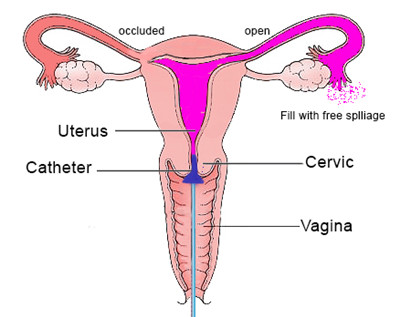Nowadays, many females are confused by the blocked fallopian tubes. But how do they know if they are attacked by this disease? Hysterosalpingogram (HSG) is the main examination for the blocked fallopian tubes.

HSG is an X-ray test that looks at the inside of the uterus and fallopian tubes and the area around them. It is often done for women who are having a hard time of becoming pregnant (infertile) because of the blocked fallopian tube.
Before the test, you may get a sedative or ibuprofen (such as Advil) to help you relax and to relax your uterus so it will not cramp during the test. You will need to take off your clothes below the waist and drape a gown around your waist. You will empty your bladder and then lie on your back on an examination table with your feet raised and supported by stirrups. This allows your doctor to look at your genital area.
During a hysterosalpingogram, a dye (contrast material) is put through a thin tube that is put through the vagina and into the uterus. Because the uterus and the fallopian tubes are hooked together, the dye will flow into the fallopian tubes. Pictures are taken using a steady beam of X-ray (fluoroscopy) as the dye passes through the uterus and fallopian tubes. The pictures can show problems such as an injury or abnormal structure of the uterus or fallopian tubes, or a blockage that would prevent an egg moving through a fallopian tube to the uterus. A hysterosalpingogram also may find problems on the inside of the uterus that prevent a fertilized egg from attaching (implanting) to the uterine wall.
Your doctor will put a smooth, curved speculum into your vagina. The speculum gently spreads apart the vaginal walls, allowing him or her to see the inside of the vagina and the cervix. The cervix may be held in place with a clamp called a tenaculum. The cervix is washed with a special soap and a stiff tube (cannula) or a flexible tube (catheter) is put through the cervix into the uterus.
The X-ray dye is put through the tube. If the fallopian tubes are open, the dye will flow through them and spill into the belly where it will be absorbed naturally by the body. If a fallopian tube is blocked, the dye will not pass through. The X-ray pictures are shown on a TV monitor during the test. If another view is needed, the examination table may be tilted or you may be asked to change position. This test should be done 2 to 5 days after your menstrual period has ended and you must be sure you are not pregnant. You may want to bring along a sanitary napkin to wear after the test because some leakage of the X-ray dye may occur along with slight bleeding.
The dye used during a hysterosalpingogram can cause kidney damage in people with poor kidney function. If you have a history of kidney problems, blood tests (creatinine, blood urea nitrogen) may be done before the hysterosalpingogram to check that your kidneys are working well. After the test, the cannula or catheter and speculum are removed. This test usually takes 15 to 30 minutes.
After diagnosed, it isn't necessary to worry because the blocked fallopian tube can be curable. Antibiotics and surgery are common therapies for females. However, the Chinese herbal medicine such as Fuyan Pill seems to be more popular nowadays because of its effectiveness and no side effects.

